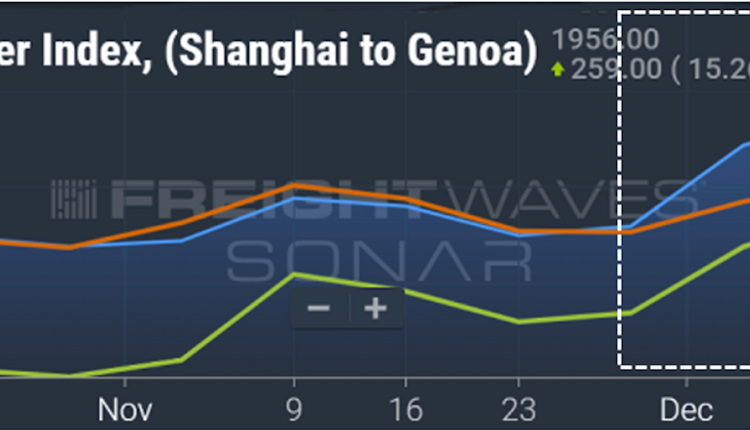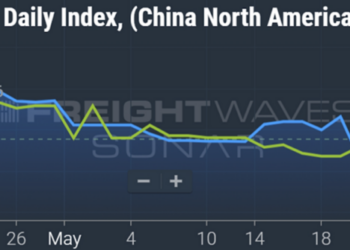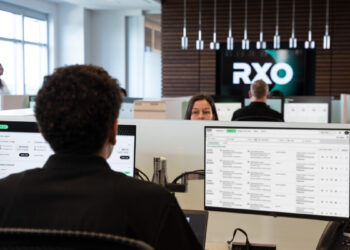The longer container lines detour from the Red Sea around the Cape of Good Hope, the more vessel capacity will be soaked up, and the higher freight rates will go. Rates are already rebounding. New surcharges just announced by ocean carriers imply freight costs are headed higher still.
Container lines have a perfectly valid reason to avoid through the Bab-el-Mandeb Strait from a corporate governance perspective: They cannot guarantee the safety of their seafarers, ships or cargo due to indiscriminate attacks by Yemen’s Houthi rebels.
From a bottom-line perspective, the timing couldn’t be better. The Red Sea-driven rate rise coincides with annual contract negotiations for Asia-Europe service that renew Jan. 1.
If disruptions extend for months, not weeks, they will impact negotiations for Asia-U.S. annual contracts that renew May 1. Numerous Asia-East Coast services that previously transited the Panama Canal switched to the Red Sea/Suez Canal route due to drought-induced restrictions in Panama.
The U.S. and its allies have unveiled Operation Prosperity Guardian in an attempt to convince shipping lines it’s safe to come back to the Red Sea, a move some analysts initially thought would bring a swift resolution, minimizing container rate upside.
But a press conference by Defense Department spokesman Major General Patrick Ryder on Thursday (transcript here) offered little guarantee that disruptions will end soon — unless civil-war-hardened Houthis are easily cowed by tough talk.
‘Think of it as the highway patrol’
Ryder made no mention of full-scale military-escorted convoys for commercial ships. Rather, he said Operation Prosperity Guardian would provide expanded patrols, i.e., what the U.S. Navy is already doing, but with more warships and international partners.
“The [Houthis] have become bandits along the international highway that is the Red Sea,” he said. “And so, the forces assigned to Operation Prosperity Guardian will serve as a highway patrol of sorts, patrolling the Red Sea and Gulf of Aden to respond to and assist commercial vessels as necessary.
“The distance we’re talking about here, from the Suez Canal down to the Gulf of Aden, is about the distance from Boston to Washington, D.C., so you’re talking about a pretty extensive stretch of water that the international community will be covering.”
Asked whether the member nations of Operation Prosperity Guardian have the authority to attack Houthi targets in Yemen, or whether it is primarily a defensive operation, Ryder responded, “This is a defensive coalition. Again, think of it as the highway patrol to safeguard maritime.”
There was a veiled threat of retaliation, however.
“The Houthis need to stop these attacks,” Ryder said. “They need to stop them now. And they really need to ask themselves if they’ve bitten off more than they can chew when it comes to taking on the entire international community and negatively impacting billions and billions of dollars in global trade.”
‘Like 20 police cruisers trying to cover entire Pacific coast’
James Stavridis, vice chairman of global affairs at the Carlyle Group, addressed the shortcomings of an expanded-patrol-only option in an op-ed piece in Bloomberg on Tuesday.
“The sea space that the maritime operators must cover is remarkably vast. The Red Sea — from the Suez Canal to the Bab-el-Mandeb on the horn of Africa — is the size of California. To cover the rest of the North Arabian Sea and the approaches to the Red Sea, you can add another chunk nearly double the size of Alaska.
“Even if you had 20 warships on patrol — a very high number for a maritime mission — it would be like 20 police cruisers trying to cover America’s entire Pacific Coast,” wrote Stavridis.
“The U.S. and its partners may have to do more than put additional warships on defensive patrol,” he said. “We must be prepared to go on offense: to carry out offensive strikes against targets ashore … against Houthi infrastructure on the southern Arabian peninsula.”
Nightmare scenario: A ‘lucky strike’
Investment bank Evercore ISI held a client webinar on the Red Sea crisis on Thursday, featuring Michael Rubin, a senior fellow at think tank American Enterprise Institute and director of policy analysis at the Middle East Forum.
Rubin dubbed Operation Prosperity Guardian “military virtue signaling.”
His concern is that the crisis will escalate if the Houthis get a “lucky strike” that kills American Navy personnel.
“The nightmare scenario is … you have a situation like the U.S.S. Cole and there’s a lucky strike on an American ship and 30 people get killed or the ship is crippled. That’s going to change the dynamic in Washington, especially against the backdrop of an election campaign.”
According to Rubin, “The model in many people’s minds goes back to the counter-piracy efforts with regard to Somalia. There you had an international task force.
“The difference between that and what we’re seeing here is that off the coast of Somalia you were in deep blue territory — deep blue in terms of ocean depth and so forth. Therefore, the ships we were sending were largely out of range or they could hang out in areas that were out of range until they needed to move forward to render assistance.
“With the Bab-el-Mandeb, you’re going to be in range of almost anything when you enter that area. So, it becomes a much more difficult problem set for the U.S. Navy. It becomes vulnerable to drones. It becomes vulnerable to cruise missiles, and it becomes vulnerable to speed boats laden with explosives.”
Asia-Med spot rates rising fast
Spot rate indexes already show a significant effect from the Red Sea attacks.
The Shanghai Containerized Freight Index (SCFI) jumped 15% this week, driven by a 45% week-on-week surge in Shanghai-North Europe rate assessments.
The Drewry World Container Index (WCI) put average spot rates from Shanghai to Genoa, Italy, at $1,956 per FEU for the week ending Thursday, up 40% since the last week of November.
The WCI assessment for Shanghai to Rotterdam, Netherlands, was at $1,667 per FEU, up 42% over the same period. The WCI Global Composite was at $1,661 per FEU, up 20%.
Spot rate in USD per FEU. Blue line: Shanghai-Genoa. Green line: Shanghai-Rotterdam. Orange line: global average. (Chart: FreightWaves SONAR)
According to data from Xeneta, spot rates in the Asia-Mediterranean market averaged $2,327 per FEU on Friday, with the low spot rate at $1,578 per FEU and the high at $3,000 per FEU. The average spot rate was 45% above the average contract rate signed in the past three months of $1,603 per FEU.
The average Asia-Mediterranean spot rate has increased 34% since Nov. 30 and 24% since Dec. 14, according to Xeneta data.
(Chart: Xeneta)
Carriers tack on emergency charges
While rates are rising, ocean carrier profits will not increase to the same extent, because their costs are also up due to sudden diversions. Longer voyages hike fuel bills and other expenses.
Carriers are now adding charges to offset those costs.
MSC has introduced a contingency adjustment charge (CAC). It is adding a CAC of $1,500 per FEU on shipments from the Middle East and India to Europe starting Saturday, and $1,500 per FEU for shipments from the Middle East and India to the U.S. East and Gulf coasts starting Jan. 18.
MSC said that it was invoking clause 19.2 of its bill of lading, which states that it reserves the right to charge additional freight and is not responsible for delays.
Other carriers are adding similar charges.
Hapag-Lloyd added an emergency revenue charge of $2,000 per FEU on cargo scheduled to transit the Suez eastbound through the end of the month, and $3,000 per FEU on westbound cargo.
Maersk is levying a transit disruption surcharge of $400 per FEU for cargo on the water that was diverted from the Red Sea, and a peak season surcharge of $1,000 per FEU starting Jan. 1 for Asia-North Europe cargo, $2,000 per FEU for Asia-Mediterranean cargo, and $600 per FEU for Asia-U.S. East Coast cargo.
Click for more articles by Greg Miller
Related articles:
Red Sea fallout much greater for containers than tankers, bulkers
Red Sea chaos should boost tanker and container shipping rates
Why attacks on container ships caused container stocks to jump
Container shipping outlook 2024: Rising risk of delays, disruptions
Zim container ships divert as threat to Israel-linked vessels mounts
Yet another shipping ‘chokepoint’ risk as Yemen rebels attack
How Middle East war could impact global LNG, LPG shipping
War in Israel: The new geopolitical flashpoint for ocean shipping
The post US-led forces in Red Sea will be defensive ‘highway patrol’ appeared first on FreightWaves.














